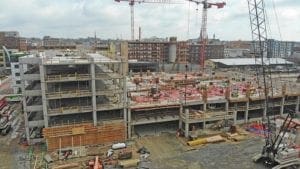
Construction Update: Studio Park – Grand Rapids, MI
WGI provided prime, parking consulting, and structural engineering services for the parking structure.
Learn from award-winning professionals — explore our whitepapers, blogs, and the latest industry updates.
Join our dynamic organization of engineers, land surveyors, landscape architects, environmental scientists, and architects!
Talk to a market leader today! We’ll answer any questions you have about our professional services.
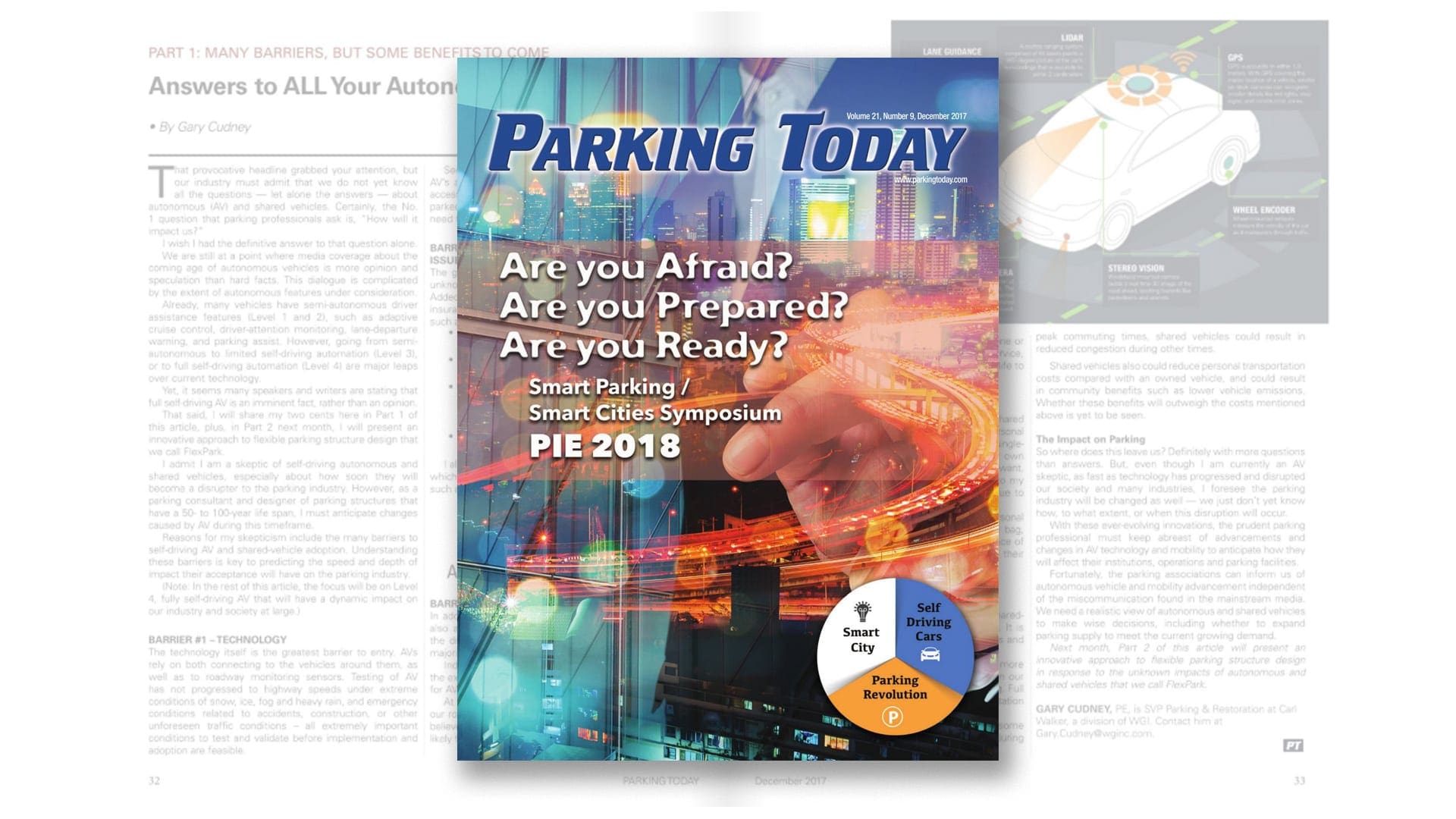
This article appeared in the December 2017 issue of Parking Today. Click here to view the article.
by Gary Cudney, PE
That provocative headline grabbed your attention, but our industry must admit that we do not yet know all the questions — let alone the answers — about autonomous (AV) and shared vehicles. Certainly, the No. 1 question that parking professionals ask is, “How will it impact us?”
I wish I had the definitive answer to that question alone.
We are still at a point where media coverage about the coming age of autonomous vehicles is more opinion and speculation than hard facts. This dialogue is complicated by the extent of autonomous features under consideration.
Already, many vehicles have semi-autonomous driver assistance features (Level 1 and 2), such as adaptive cruise control, driver-attention monitoring, lane-departure warning, and parking assist. However, going from semi-autonomous to limited self-driving automation (Level 3), or to full self-driving automation (Level 4) are major leaps over current technology.
Yet, it seems many speakers and writers are stating that full self-driving AV is an imminent fact, rather than an opinion.
That said, I will share my two cents here in Part 1 of this article, plus, in Part 2 next month, I will present an innovative approach to flexible parking structure design that we call FlexPark.
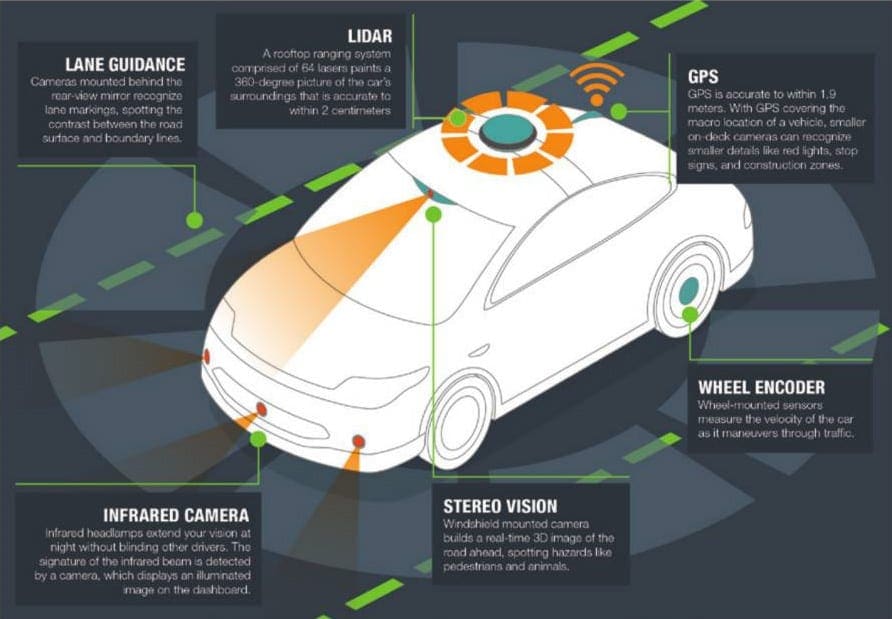
I admit I am a skeptic of self-driving autonomous and shared vehicles, especially about how soon they will become a disrupter to the parking industry. However, as a parking consultant and designer of parking structures that have a 50- to 100-year life span, I must anticipate changes caused by AV during this timeframe.
Reasons for my skepticism include the many barriers to self-driving AV and shared-vehicle adoption. Understanding these barriers is key to predicting the speed and depth of impact their acceptance will have on the parking industry.
(Note: In the rest of this article, the focus will be on Level 4, fully self-driving AV that will have a dynamic impact on our industry and society at large.)
The technology itself is the greatest barrier to entry. AVs rely on both connecting to the vehicles around them, as well as to roadway monitoring sensors. Testing of AV has not progressed to highway speeds under extreme conditions of snow, ice, fog and heavy rain, and emergency conditions related to accidents, construction, or other unforeseen traffic conditions – all extremely important conditions to test and validate before implementation and adoption are feasible.
Seemingly easier technology issues to resolve are the AV’s ability to find open parking, enter with autonomous access control, and exit upon automatic payment. Once parked, autonomous electric-vehicle (EV) charging will also need to occur.
The governmental regulation process for AV is still a big unknown and includes federal, state and local governments. Added to that complexity are the myriad of legal and insurance issues. Tough questions will need to be answered, such as:
I also envision heavy lobbying by special interest groups which might be “disrupted” by AV and shared vehicles, such as auto dealers, truckers and oil companies.
The No. 1 question that parking professionals ask is, “How will Autonomous Vehicles impact us?”
In addition to the technical and legal complications, there also are cost issues. When they initially hit the market, the driverless AV’s prohibitive cost will likely exclude the majority of people, inhibiting widespread adoption.
Individuals are not the only ones facing a larger price tag; the extent of roadway infrastructure improvements needed for AV is not fully understood, let alone funded.
At present, we can’t seem to fix the existing potholes in our roads or repair deteriorated bridges, which leads me to believe funding for roadway improvements for AVs are also likely to be problematic.
Not only must the AV equipment prove reliable, but consumers must trust in it — which is a separate issue. Younger generations are more apt to consider the AV, but are least able to afford its higher cost. With all the technology problems that occur in everyday life — such as high-maintenance computerized kitchen appliances, computer software glitches, need for phone or computer reboots, viruses, hacking, dropped cell service, and inaccurate map guidance — would you trust your life to a computer driving a vehicle at 75 mph? I don’t, yet.
To my mind, the bigger behavioral leap is going to a shared vehicle — 86% of Americans still commute in a personal vehicle, and 90% of those commuters are in their own single-occupancy vehicle. We want the convenience of our own auto and the freedom to go where we want, when we want.
I have tried shared shuttle rides from the airport to my hotel while traveling, and have always regretted it due to the added wait and travel time.
When considering all the stuff we carry in our personal vehicles, such as child car seats, golf clubs, a gym bag, bike and kayak racks, etc., overcoming the convenience of a personal vehicle in trade for shared vehicles make their adoption even more challenging.
While there are many barriers to autonomous and shared-vehicle adoption, there are many purported benefits. It is claimed that compared with human drivers, accidents and vehicle-related deaths will drop by 90% with the AV.
In addition, a full self-driving AV could provide more productive commuting time as we can read, work on our phone or computer, or even sleep if we are not driving. Full self-driving AV also could offer a convenient transportation option for the elderly, disabled or non-drivers.
An increase in shared vehicles could also yield some benefits. While there would still be an influx of cars during peak commuting times, shared vehicles could result in reduced congestion during other times.
Shared vehicles also could reduce personal transportation costs compared with an owned vehicle, and could result in community benefits such as lower vehicle emissions. Whether these benefits will outweigh the costs mentioned above is yet to be seen.
So where does this leave us? Definitely with more questions than answers. But, even though I am currently an AV skeptic, as fast as technology has progressed and disrupted our society and many industries, I foresee the parking industry will be changed as well — we just don’t yet know how, to what extent, or when this disruption will occur.
With these ever-evolving innovations, the prudent parking professional must keep abreast of advancements and changes in AV technology and mobility to anticipate how they will affect their institutions, operations and parking facilities.
Fortunately, the parking associations can inform us of autonomous vehicle and mobility advancement independent of the miscommunication found in the mainstream media. We need a realistic view of autonomous and shared vehicles to make wise decisions, including whether to expand parking supply to meet the current growing demand.
Next month, Part 2 of this article will present an innovative approach to flexible parking structure design in response to the unknown impacts of autonomous and shared vehicles that we call FlexPark. Click Here to read Part 2 of this article.

WGI is a national design and professional services firm leading in technology-based solutions for the construction of public infrastructure and real estate development. At WGI, we’re providing Tomorrow’s Infrastructure Solutions Today.

WGI provided prime, parking consulting, and structural engineering services for the parking structure.

Strategies for a Healthier Parking Facility. Promote public health and protect patrons with these operational management strategies.

Underground parking is an ideal way for a city to make better use of public real estate, encourage private development, and return public property to the tax roll.
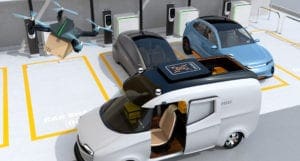
An e-commerce revolution has rapidly increased delivery activity. Flexible Design provides the framework for anticipating disruptive trends & impacts.
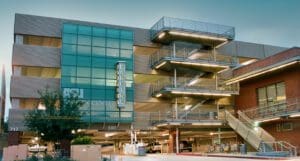
Despite campus parking returning to pre-COVID demand, university parking departments are being asked to do more with less.
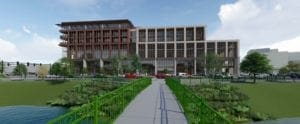
WGI developed functional and structural designs for Catalyst Development’s new $70M, seven-story, mixed-use building in Kalamazoo, Michigan.
You’ve been searching for a place like WGI. We look forward to meeting you soon.
Sign up to receive emails to hear our latest news and achievements in our monthly newsletter.
Enter your zip code, and we’ll personalize your experience with local projects, office locations, team members, and more.
WGI supports its associates with meaningful opportunities for growth, strong benefits and perks, while we work collaboratively with clients and co-consultants to shape and improve communities.






WGI is a dynamic organization with opportunities nationwide for engineers, land surveyors, landscape architects, environmental scientists, and architects.